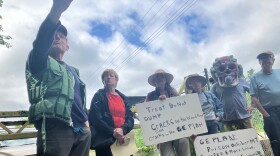General Electric presented its plan this week for transporting contaminated sediment excavated from the Housatonic River.
At a public meeting in Lee, Massachusetts, the company said it wants to use a combination of hydraulic pumps and trucks to move soil and sediment containing toxic PCBs from staging areas along the river or directly from the river itself.
A company spokesperson said the plan "minimizes, to the greatest possible extent, impacts on local communities."
GE used PCBs, or polychlorinated biphenyls, from the 1930s into the 1970s when it manufactured electrical transformers at its former plant on the river in Pittsfield. Congress banned the chemical compound in 1979 because of its toxicity. PCBs have been found in the river and floodplain sediment, as well as in vernal pools and behind dams.
Andy Silfer, General Electric's Housatonic River project coordinator, presented the company's recommendations. GE wants to pump more than half of the waste from the river to a planned PCB disposal facility in Lee and use trucks to move the rest. He said pumping soil and water "would eliminate the need for over 55,000 truck trips," or "about 47 truck trips a day."
Anni Loughlin with EPA New England said the agency is actively reviewing GE's plan. She added the public has until February 1, 2024 to submit comments, which the agency will consider before approving or disapproving the plan.
The Environmental Protection Agency's cleanup plan includes a disposal facility in Lee for waste with lower concentrations of PCBs. Waste with higher levels of the toxin will be sent to a licensed facility out of state.
The plan is to put about 900,000 cubic yards of material containing lower levels of PCBs in the disposal facility and ship at least 100,000 cubic yards out of state.
But many Lee residents and officials oppose the dump and propose shipping all of the waste via rail to facilities out of state that are licensed to store it.
A report commissioned by GE said it is choosing truck routes with "limited residential development." The report also concluded that to move material via rail, a railroad siding is needed close to the staging areas on the river, but there "are currently no active railroad sidings available..."
Charles Kenney, the chair of the Tri Town of Board of Health, which serves Lee, Lenox and Stockbridge, said GE's plan was "seriously misleading."
He said it was predicated on the idea that existing rail staging would have to be remodeled and that existing rail siding is located at "inconvenient distances" from where the material is excavated.
"The consideration that new rail staging could be constructed is not in this proposal at all," Kenney said. "The footprint for the staging is very likely to be the same places where the truck staging could occur."
Just hours before the meeting, Lee select board chair Bob Jones received an email from Parker Rodriguez, an attorney with the Housatonic Railroad Company, saying the company "would be willing to contribute some track and possibly labor" to construct siding. Jones read the letter aloud during the meeting.
Jones, who is against the PCB dump in Lee, not only wants GE to use railroad tracks that line the river, but to move all the waste out of state.
"Now, there would have to be some upgrades on those [railroad] sidings, but you're going to have to do the same things if they use trucks, because you have to make the river accessible to trucks as well," Jones said.
When GE and the EPA completed a cleanup of PCBs from the first two miles of the river, trucks were used to transport the waste. This next part of the cleanup, known as 'Rest of River,' will begin at the confluence of the east and west branches of the river in Pittsfield and continue downstream about ten miles to Rising Pond Dam in Great Barrington.
“While it is safe to swim in the river, PCBs pose unacceptable cancer and noncancer risks to human health. That’s mostly from through fish consumption," Loughlin said at the meeting. " In certain reaches of the river, direct contact with floodplain soil, like through recreational activities also poses a threat to human health."
The construction of the PCB disposal facility in Lee is estimated to start in 2025, according to GE.











